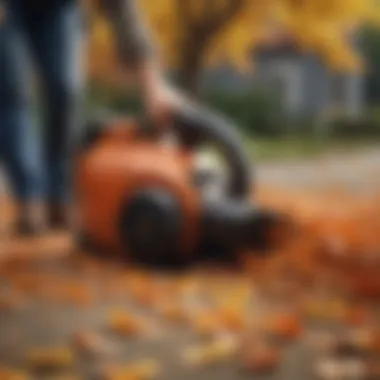Master the Art of Leaf Removal: A Comprehensive Guide for a Pristine Yard


Overview of the Topic
Greetings, dear readers! Today, we delve into the intricate world of yard maintenance, focusing particularly on the arduous task of leaf removal. As the seasons transition and leaves carpet the ground, it becomes imperative to know the right tools and techniques for a pristine outdoors.
Current Status and Challenges
In the realm of yard care, the seasonal shedding of leaves poses a significant challenge to homeowners and garden enthusiasts alike. The accumulation of fallen leaves not only mars the aesthetic appeal of the yard but also hinders essential processes like grass growth and soil aeration. These organic debris can lead to the formation of thatch, impacting the health of the lawn.
Sustainable Solutions
Amidst these challenges, embracing sustainable practices in leaf removal can pave the way for a greener future. From composting leaves to utilizing them as mulch or employing manual raking techniques instead of gas-powered blowers, there exist myriad eco-friendly solutions. By adopting these practices, not only can we maintain a clean yard but also contribute positively to the environment.
Impact and Importance
The impact of effective leaf removal extends far beyond aesthetic appeal. By ensuring a leaf-free yard, we promote healthy soil quality, foster biodiversity by creating conducive habitats for beneficial insects, and reduce the need for chemical interventions. Moreover, in the broader context, sustainable yard maintenance aligns with conservation efforts and underscores our responsibility towards fostering sustainable ecosystems for future generations.
Understanding the Importance of Leaf Removal
Leaf removal in your yard is a critical aspect of maintaining a healthy outdoor space. The presence of leaves can have significant impacts on the overall well-being of your yard. Firstly, leaves can cause nutrient blockage, inhibiting the access of essential nutrients to your soil and plants. This blockage can lead to stunted growth and poor health in your yard. Additionally, leaves provide an ideal habitat for pests to thrive, increasing the risk of infestations that can damage your landscaping. Furthermore, the accumulation of leaves can detract from the aesthetic appeal of your yard, making it look unkempt and neglected. Therefore, regular leaf removal is essential to mitigate these issues and promote a visually pleasing and healthy outdoor environment.
Impact of Leaves on Your Yard
Nutrient Blockage
Nutrient blockage occurs when leaves cover the soil, preventing sunlight and moisture from reaching the ground. This inhibits the natural process of photosynthesis and nutrient absorption by plants, ultimately affecting their growth and vitality. While leaves can decompose over time and provide some nutrients, excessive leaf coverage can lead to imbalances in the soil composition, hindering plant development. Proper removal of leaves is crucial to prevent nutrient blockage and ensure optimal soil health in your yard.
Pest Habitat
Leaves create a conducive environment for pests to breed and thrive. Piles of leaves serve as ideal hiding spots and breeding grounds for insects and rodents that can cause damage to your yard and plants. By removing leaves promptly, you can disrupt the habitat of these pests and reduce the risk of infestations. Maintaining a leaf-free yard is essential in preserving the health and integrity of your outdoor space.
Aesthetic Appeal
The presence of scattered leaves can detract from the visual appeal of your yard, making it appear messy and neglected. A clean and tidy outdoor space enhances the overall aesthetic of your property, creating a welcoming environment for both residents and visitors. Regular leaf removal is key to maintaining a well-groomed and visually pleasing yard that reflects your attention to detail and care for your home.
Benefits of Regular Leaf Removal
Promotes Grass Growth


Regular leaf removal allows grass to receive sufficient sunlight, water, and nutrients for healthy growth. Accumulation of leaves can inhibit grass growth by blocking essential resources, leading to patchy and sparse lawns. By keeping your yard free of leaves, you promote lush and vibrant grass that enhances the beauty of your outdoor space.
Prevents Mold and Fungus
Leaves retain moisture and create a damp environment that is conducive to mold and fungus growth. Wet and decaying leaves provide a breeding ground for various fungi that can harm plant life and create unsightly patches in your yard. Removing leaves regularly helps maintain a dry and healthy environment, reducing the risk of mold and fungus proliferation in your landscaping.
Enhances Overall Yard Health
Overall yard health is greatly improved by the regular removal of leaves. Accumulated leaves can suffocate plants, disrupt the natural ecosystem, and invite disease and pests into your yard. By keeping your outdoor space clean and free of debris, you promote the well-being of your plants, maintain soil quality, and create a thriving and sustainable environment for both flora and fauna.
Choosing the Right Tools for Leaf Removal
In the realm of yard maintenance, the significance of selecting the appropriate tools for leaf removal cannot be overstated. It is a pivotal aspect that can determine the efficiency and effectiveness of your yard upkeep endeavors. The precise choice of tools can streamline the process and yield optimal results. By focusing on the specific requirements of your yard and the task at hand, you can enhance the overall outcome of your leaf removal efforts.
Essential Tools for Efficient Leaf Removal
Leaf Blower
When considering leaf removal, the leaf blower stands out as an essential tool in your arsenal. Its specialized design and functionality make it a go-to choice for efficiently clearing leaves from your yard. The key characteristic of a leaf blower lies in its ability to blow leaves into manageable piles, facilitating easy collection and disposal. This feature significantly reduces the manual effort required for leaf removal, making the task less labor-intensive and time-consuming. While the leaf blower offers remarkable advantages in terms of speed and convenience, some may find it challenging to handle for precise leaf manipulation.
Rake
Another crucial tool for effective leaf removal is the humble rake. The simplicity and versatility of a rake make it a popular choice for many yard owners. Its key characteristic lies in its ability to gather leaves with precision, allowing for thorough cleaning of the yard. The unique feature of a rake is its manual operation, which provides a hands-on approach to leaf removal, ideal for smaller yards or intricate landscapes. While a rake offers control and precision, it can be physically demanding for larger yards or extensive leaf coverage.
Mulching Mower
In the realm of leaf removal, the mulching mower presents a distinct approach to managing fallen leaves. Its key characteristic lies in its dual functionality of simultaneously mowing and mulching leaves into fine particles. This not only clears the yard of leaves but also adds organic matter back into the soil, enriching its nutrient content. The unique feature of a mulching mower is its eco-friendly approach to leaf disposal, promoting sustainability in yard maintenance practices. Despite its eco-friendly benefits, some may find mulching mowers less effective for heavy leaf coverage or debris like twigs and branches.
Factors to Consider When Selecting Tools
Yard Size
The size of your yard plays a crucial role in determining the most suitable tools for leaf removal. For larger yards, a leaf blower or mulching mower may offer greater efficiency, while rakes are ideal for smaller spaces that require detailed cleaning. The key characteristic of yard size is its impact on the choice of tools, influencing the ease and speed of leaf removal. Smaller yards may benefit from manual tools like rakes for precise cleaning, whereas larger yards necessitate powered tools for enhanced productivity.
Budget
When selecting tools for leaf removal, your budget plays a significant role in determining the available options. While high-end leaf blowers or mulching mowers offer advanced features and functionality, budget-friendly rakes can provide a cost-effective solution for basic yard maintenance. The key characteristic of budget considerations is their influence on the quality and durability of the tools chosen, balancing cost-effectiveness with performance. Understanding your budget constraints can help prioritize essential tools without compromising on their effectiveness.
Eco-Friendly Options


In the current era of environmental awareness, opting for eco-friendly tools for leaf removal is a sustainable choice with long-term benefits. Eco-friendly options prioritize minimal environmental impact through efficient resource utilization and waste management. The key characteristic of eco-friendly choices lies in their contribution to sustainable yard maintenance practices, promoting biodiversity and ecosystem health. While eco-friendly options align with conservationists and environmentalists, some individuals may find them marginally less powerful or efficient compared to traditional tools.
Effective Techniques for Leaf Removal
In this article, the focus shifts towards the critical aspect of removing leaves efficiently within your yard. Understanding the significance and nuances of effective techniques holds the key to maintaining a pristine outdoor space. By delving into specific elements, benefits, and considerations associated with effective leaf removal techniques, you are equipped with the knowledge necessary to tackle this task adeptly. Proper execution of these techniques ensures the health and aesthetics of your yard are upheld to the highest standard.
Proper Raking Techniques
Utilizing Proper Grip
Proper grip while raking plays a pivotal role in the overall success of your leaf removal process. The key characteristic of utilizing a proper grip lies in its ability to maximize efficiency and minimize strain on your hands and arms, thereby enhancing your productivity. This technique is a popular choice within this article due to its ergonomic benefits and its effectiveness in ensuring leaves are gathered swiftly and without causing unnecessary fatigue. Moreover, the unique feature of this method lies in its adaptability to various raking styles, making it a versatile and advantageous approach in the context of this guide.
Dividing Yard into Sections
Dividing your yard into manageable sections is a strategic approach that significantly contributes to the overall efficiency of your leaf removal endeavors. By segregating the yard, you can systematically address specific areas, ensuring thorough cleaning and preventing oversights. The key characteristic of this method is its ability to streamline the process, making it a convenient and popular choice among effective leaf removal strategies. While enhancing precision and organization, this technique also aids in maintaining a structured approach, thereby mitigating the chances of missing any areas during the cleaning process.
Creating Piles for Efficient Collection
Creating piles for efficient collection optimizes the leaf gathering process and facilitates easy disposal. The key characteristic of this approach is its ability to centralize the leaves, making subsequent steps such as bagging or mulching more streamlined. This method's unique feature lies in its capacity to expedite the cleaning process while promoting a clutter-free yard. While advantageous in promoting efficient leaf removal, it is essential to manage these piles strategically to avoid hindering other aspects of yard maintenance throughout this article.
Using Leaf Blowers Strategically
Using leaf blowers strategically is a crucial component in the arsenal of effective leaf removal techniques. By properly understanding and implementing the nuances of this method, you can significantly expedite the cleaning process and achieve optimal results in maintaining your outdoor space.
Adjusting Blowing Speed
One specific aspect worth emphasizing is the adjustment of blowing speed when using a leaf blower. The key characteristic of this practice lies in its ability to cater to different types of leaves and yard sizes. By fine-tuning the blowing speed, you can effectively control the movement of leaves, ensuring efficient collection without causing damage to your yard. This feature's unique quality is its adaptability, allowing you to customize the cleaning process according to the specific requirements of your lawn maintenance, making it a valuable choice in the context of this guide.
Directing Leaves Towards Center
Directing leaves towards the center of your yard is a strategic maneuver that enhances the efficacy of your leaf removal efforts. By concentrating the leaves in one area, you simplify the collection process and minimize scatter, facilitating quicker and more organized cleanup. The key characteristic of this method is its ability to create a central collection point, streamlining subsequent disposal steps and promoting a tidier yard. This technique's unique feature lies in its ability to optimize the use of leaf blowers, allowing for efficient and targeted cleaning that avoids unnecessary dispersion of leaves.
Avoiding Damage to Landscaping
Avoiding damage to landscaping is paramount when utilizing leaf blowers during the cleaning process. The key characteristic of this aspect is its focus on safeguarding the aesthetics and structural integrity of your outdoor space while effectively removing leaves. By being mindful of the potential impact of blowers on delicate plants, flowers, or garden features, you ensure that the cleaning process enhances, rather than detracts from, the overall landscape. The unique feature of this practice is its ability to balance thorough leaf removal with landscape protection, making it an essential consideration for maintaining a well-manicured and flourishing yard in the context of this comprehensive guide.
Eco-Friendly Leaf Disposal Methods


As we delve into the crucial aspect of eco-friendly leaf disposal methods, it is imperative to understand their significance in maintaining a sustainable outdoor environment. By embracing eco-friendly practices, we contribute to the well-being of our surroundings and reduce the ecological footprint left by traditional leaf removal techniques. Managing fallen leaves in an eco-conscious manner not only nurtures biodiversity but also aids in promoting healthy soil and plant growth. In this section, we will explore the various elements, benefits, and considerations associated with eco-friendly leaf disposal methods to empower you in making environmentally responsible choices for your yard maintenance.
Composting Leaves
Composting leaves is a fundamental technique that aligns with the ethos of sustainability and resourcefulness. Creating a compost pile from organic materials such as fallen leaves offers a natural and beneficial way to recycle and enrich the soil in your yard. The key characteristic of composting leaves lies in its ability to transform organic matter into nutrient-rich humus, providing a natural fertilizer for your plants. This method stands out as a popular choice in our article for its eco-friendly approach to waste reduction and soil nourishment. However, it's essential to note that successful composting requires a balance of green and brown materials, aeration, and moisture to facilitate the decomposition process effectively.
Benefits of Leaf Compost
The benefits of leaf compost extend beyond typical yard maintenance practices. Utilizing leaf compost enriches the soil with vital nutrients, improves soil structure, and fosters microbial activity in the earth, which are all crucial elements for sustaining a healthy garden ecosystem. Leaf compost serves as a cost-effective and sustainable alternative to chemical fertilizers, promoting long-term soil health and plant vitality. Its unique feature lies in its ability to mimic natural nutrient cycling processes, ensuring a harmonious relationship between plants and soil microorganisms. While the advantages of leaf compost are abundant, attention to proper composting techniques and ingredient ratios is paramount to achieving optimal results.
Tips for Successful Composting
To ensure successful composting of leaves, adhering to key tips can significantly enhance the effectiveness of this eco-friendly practice. Maintaining a proper balance between carbon and nitrogen-rich materials, turning the compost regularly to aerate it, and monitoring moisture levels are crucial aspects of successful composting. The unique feature of tips for composting lies in their practicality and accessibility, guiding both novice and experienced gardeners in crafting nutrient-dense compost for their yard. By following these tips, you can harness the full potential of composting leaves, fostering a sustainable and regenerative cycle of organic matter within your outdoor space.
Final Steps and Cleanup
In the intricate process of revamping your yard by removing leaves, the final steps and cleanup hold utmost significance. This phase is not merely about the completion of the task but delves deeper into the assurance of a well-maintained, tidy outdoor space. Emphasizing attention to detail, the final steps entail thorough inspection and meticulous cleanup to ensure no remnants affect the immaculate appearance of your yard. By investing effort and time in this conclusive stage, you secure the long-term health and aesthetic appeal of your outdoor environment, showcasing dedication to preservation and cleanliness.
Inspecting Your Yard
Checking for Remaining Leaves
When it comes to inspecting your yard post leaf removal, checking for remaining leaves stands out as a pivotal task. This critical step involves a detailed examination of your property to detect any overlooked leaves that might compromise the overall tidiness. By meticulously scanning the lawn, flower beds, and nooks of your yard, you prevent potential hindrances to drainage, sunlight exposure, and the visual appeal of your outdoor space. Ensuring a leaf-free environment not only enhances the aesthetics but also promotes the health of your yard's ecosystem, underscoring the conscientious effort put into maintaining a pristine exterior.
Assessing Lawn Health
Another vital aspect of yard inspection is the assessment of lawn health. This entails more than just superficial observation; it requires a comprehensive analysis of the grass condition, soil quality, and overall well-being of your yard. By delving into the health of your lawn post leaf removal, you gain valuable insights into any underlying issues that may affect its vitality. Whether it's addressing nutrient deficiencies, identifying pest infestations, or monitoring for signs of disease, assessing lawn health plays a crucial role in sustaining a thriving outdoor environment.
Addressing Any Issues
Addressing any identified issues during the inspection phase is key to maintaining a resilient and vibrant yard. From patchy grass areas to soil compaction or waterlogging concerns, resolving these issues promptly is essential for the long-term sustainability of your outdoor space. By tackling problems proactively, you ensure that your yard remains not only aesthetically pleasing but also functionally efficient, reflecting a commitment to holistic yard care and environmental stewardship.
Proper Storage of Tools
Cleaning and Organizing Tools
The proper storage of leaf removal tools is essential for prolonging their lifespan and ensuring their efficiency in future yard maintenance tasks. Cleaning and organizing tools post-use not only prevents rust and corrosion but also streamlines the workflow for future leaf removal endeavors. By maintaining cleanliness and orderliness in tool storage, you optimally prepare yourself for the next seasonal cycle of yard upkeep, demonstrating a structured approach to environmental management.
Storing in Dry Area
Storing leaf removal equipment in a dry area is paramount to shield them from moisture-related damages and extend their usability. Moisture can cause metal tools to rust and wooden handles to rot, compromising their functionality and efficacy. By placing tools in a dry and well-ventilated space, you safeguard them against environmental degradation, preserving their quality for subsequent yard maintenance tasks and exhibiting a conscientious attitude towards tool maintenance and longevity.
Maintenance Tips
Last but not least, adhering to maintenance tips for your leaf removal tools is vital in upholding their performance and durability. Simple practices such as oiling metal parts, sharpening blades, and inspecting handles for cracks can significantly enhance the longevity of your tools. By incorporating these maintenance tips into your regular yard care routine, you ensure that your equipment remains in top condition, ready to tackle leaf removal challenges season after season. This proactive approach to tool upkeep underscores a commitment to sustainability, resource efficiency, and meticulous attention to detail in maintaining your yard tools.



